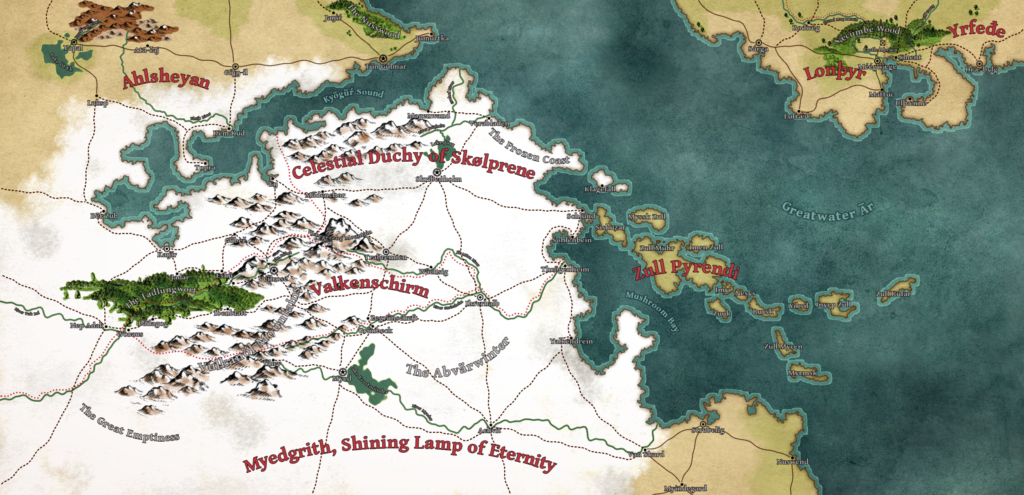Happy new year, Yore readers!
My fourth region in Godsbarrow is two map “tiles” wide, sitting south of the Unlucky Isles and the Gilded Lands. It’s the map where most of Ahlsheyan sits, plus the rest of Lonþyr and most of the rest of Yrfeđe — and new nations, of course.

As you can see above, I finished the map before the write-ups (and I’m actually still working on the tail end of the written material). But for this post I’m jumping in with the first step from Worlds Without Number [paid link]. As always, this is more or less straight from my notes in Notepad, not fully polished (etc.).
Name the region.
The Ice Courts, so called because this region is a hotbed of courtly intrigue locked in perpetual winter. Though climate and geography have always made this a cold region, the unnatural winter stems from the death of a god: Abäschern, the Wolf of Summer (“ah-bay-SHURN”). Abäschern once blessed the land, ensuring that despite its climate and geography the region was arable and full of game to hunt, and blessed its people by making them werewolves. But in time he became bored with the world, and his petty streak turned to outright cruelty. He reveled in the thrill of twisting the land to his ends and hurting his followers, and the entire region became a dark place.
A few centuries ago, the people of what is now the Ice Courts rose up, threw off their shackles, and assassinated Abäschern — and with his dying breath, the wolf-god cursed them unto a thousand generations, casting the land into winter. The curse, plus the warped energy of his magically-active corpse, keeps the Ice Courts frozen to this day.
Valkenschirm (“VAL-kenn-shurm,” linguistic touchstone: Old High German) is the heart of the Ice Courts. What Valkenschirm lacks in size and martial power it more than makes up for in magical power: The majority of Valken are werewolves, and Abäschern’s still-potent corpse is entombed here. Years of intermarriage and close ties between the nations of the Ice Courts mean that many outside Valkenschirm are also at least part werewolf (considered a noble blessing), perhaps manifesting only minor signs of their condition.
Part of the reason the Ice Courts are so full of courtly rules, fancy balls, intrigue, and polite skullduggery is that it’s too fucking cold to spent time outside. Since Abäschern’s fall, what was once one nation has split into several, and the region’s focus has turned inwards, socially and literally, with lots of infighting, political maneuvering, and posturing. Alongside centuries of refinement of this culture of intrigue, each nation has also developed its own approaches to surviving in a place where winter is the only season (magic combined with burrows or structures, digging down to geothermal vents, underground mushroom farms, peculiar trees that bear food — not just fruit — all year long, etc.).
Choose about six major geographical features.
- The Abvärwinter (“abb-FAIR-win-tur”), the local name for the area cast into perpetual winter by Abäschern’s curse, which comprises most of the Ice Courts region
- Kyögüŕ Sound (“KYU-goorh”), windy and partially iced-over, which separates most of Ahlsheyan from the rest of the Ice Courts
- The Tadlungwort (“TADD-loong-vort”), the only forest that survived the coming of the Abvärwinter, a strange evergreen wood full of even stranger animals
- The Zull Pyrendi archipelago, largely unaffected by the Abvärwinter despite being close enough that it too should be snowed under
- Vulkanöl Mountains (“VULL-kann-ole”), the massive range that covers a large portion of the Ice Courts region
- Webegezeug Mountain (“veh-BEGG-uh-zoyg”), the tallest peak in the Vulkanöl Mountains — and one of the highest in all of Dormiir, well over 8,000 meters
The next step, nations of importance, is long enough for a post of its own. Onwards!
(This post is one of a series about worldbuilding with Worlds Without Number. I’m using the setting-creation approach detailed in Worlds Without Number [paid link], which is a fantastic resource.)
